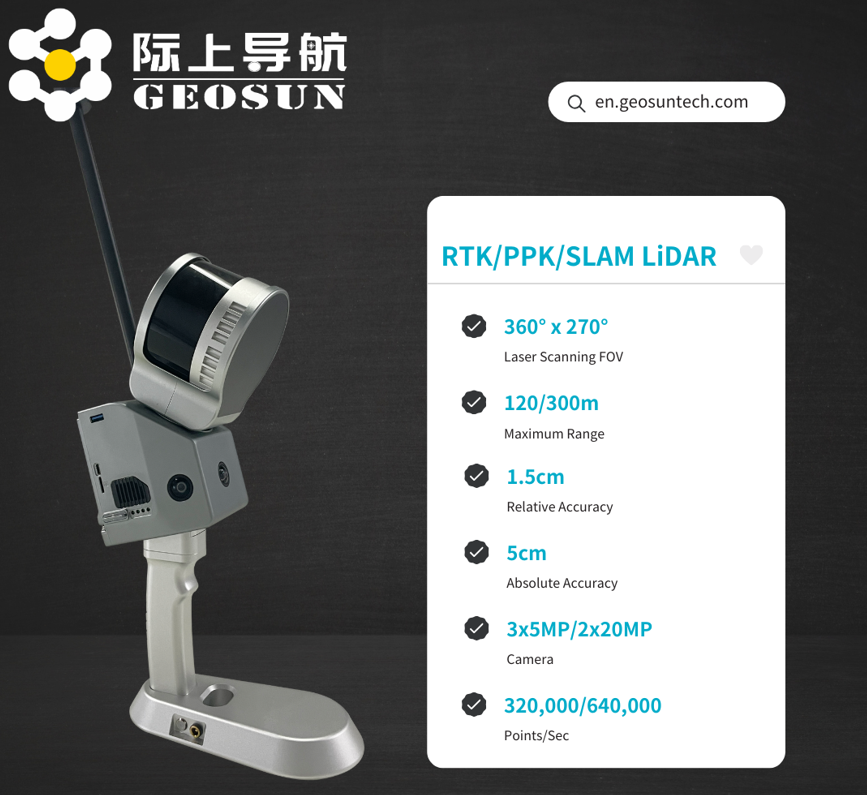
Home
Home
About Geosun
About Geosun
Products
Products
- Hardware
- Mobile LiDAR Scanning System
- gCollector Road Information Collection System
- gSpin POS System
- PPK Solution
Support
Support
News
News
Contact Us
Contact Us

Selecting the right handheld 3D LiDAR scanner is crucial for ensuring you get the best performance and value for your specific needs. Whether you're involved in construction, archaeology, environmental monitoring, or another field, understanding how to evaluate and choose the right device can significantly impact your project's success. Here's a comprehensive guide to help you make an informed decision.
Application Area: Identify the primary applications for which you need the LiDAR scanner. Different applications, such as building measurement, indoor modeling, or archaeological research, may have varying requirements for scanner features and precision.
Measurement Range and Accuracy: Consider the maximum range and required accuracy of the scanner. High accuracy and extended range often come with a higher price tag, so it’s essential to balance these factors based on your needs.

Laser Scanner Specifications: Review key specifications like measurement distance, point cloud density, and scanning speed. Ensure these parameters align with your project requirements. For example, high point cloud density provides more detailed data but may require more processing power.
Real-Time Data Processing: Some handheld 3D LiDAR systems offer real-time data processing, providing immediate feedback. This feature can be particularly valuable for applications requiring instant results.

Weight and Size: Choose a device that is manageable for extended use. The scanner’s weight and dimensions should be practical for your intended use, whether it's in the field or in a controlled environment.
Ease of Use: Ensure the scanner is user-friendly. An intuitive interface and straightforward operation are crucial for efficient and effective data collection.
Battery Duration: Check the battery life to ensure it can support your work duration. A longer battery life is essential for extended fieldwork.
Charging and Replacement: Understand the charging time and ease of battery replacement. Efficient charging and battery management can help minimize downtime.
Data Export and Compatibility: Verify that the scanner supports data formats compatible with your existing processing software. Good software support can streamline data handling and analysis.
Data Management: Consider the device’s storage capacity and data management features. Adequate storage is crucial for handling extensive data from longer scanning sessions.
After-Sales Support: Choose a brand known for good after-sales service and technical support. Investigate warranty policies, repair services, and response times for technical queries.
Training and Documentation: Check if the manufacturer provides training and comprehensive user manuals to facilitate smooth operation and troubleshooting.
Brand Credibility: Opt for reputable brands with positive reviews. Research user feedback and real-world case studies to gauge the device’s performance and reliability.
Recommendations: Seek recommendations from industry experts or colleagues who have experience with handheld 3D LiDAR scanners.
Device Cost: Consider the cost of the scanner within your budget. Higher-performance models often come at a premium, so evaluate whether the features justify the price.
Maintenance Costs: Factor in maintenance and operational costs, including calibration and upkeep, which can affect the total cost of ownership.
On-Site Demos: If possible, arrange for a live demonstration or trial of the device. Hands-on experience can provide valuable insights into the scanner’s usability and performance.
Demo Videos and Case Studies: Review manufacturer-provided demo videos and case studies to understand how the scanner performs in real-world scenarios.
By carefully evaluating these factors, you can select a handheld 3D LiDAR scanner that best fits your needs and budget. A well-chosen device will enhance your data collection processes and contribute to the success of your projects, making it a worthwhile investment for your professional toolkit.
URL:https://www.geosuntech.com/News/236.html
Previous:The Prospects and Challenges of Handheld SLAM Technology




